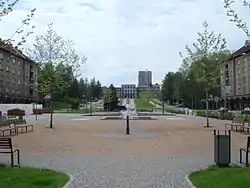Lyžbice
![]() Lyžbice (Polish:
Lyžbice (Polish: ![]() Łyżbice, German: Lischbitz) is a part of the town of Třinec in Frýdek-Místek District, Moravian-Silesian Region, Czech Republic, on the Olza River. It was a separate municipality but later became administratively a part of the town of Třinec. It lies in the historical region of Cieszyn Silesia and has a population of 17,239 (1 January 2008).[1]
Łyżbice, German: Lischbitz) is a part of the town of Třinec in Frýdek-Místek District, Moravian-Silesian Region, Czech Republic, on the Olza River. It was a separate municipality but later became administratively a part of the town of Třinec. It lies in the historical region of Cieszyn Silesia and has a population of 17,239 (1 January 2008).[1]

The name is of patronymic origins derived from personal name *Łyżba.[2]
History
The village was first mentioned in 1562 as Lyzbycz.[2][3] It belonged then to the Duchy of Teschen, a fee of the Kingdom of Bohemia and a part of the Habsburg Monarchy.
The village with Nýdek was bought from Joseph Freyherrn von Beess by Teschener Kammer in 1792 for 46,000 florins.[4]
After Revolutions of 1848 in the Austrian Empire a modern municipal division was introduced in the re-established Austrian Silesia. The village as a municipality was subscribed to the political district of Cieszyn and the legal district of Jablunkov (at least from 1880). According to the censuses conducted in 1880, 1890, 1900 and 1910 the population of the municipality grew from 1,013 in 1880 to 1,251 in 1910 with a majority being native Polish-speakers (between 96.7% and 99.7%) accompanied by Czech-speaking (at most 23 or 2.3% in 1880) and German-speaking people (at most 10 or 1% in 1880). In terms of religion in 1910 the majority were Protestants (78.4%), followed by Roman Catholics (21.6%).[5] The village was also traditionally inhabited by Cieszyn Vlachs, speaking Cieszyn Silesian dialect.
After World War I, fall of Austria-Hungary, Polish–Czechoslovak War and the division of Cieszyn Silesia in 1920, it became a part of Czechoslovakia. Following the Munich Agreement, in October 1938 together with the Zaolzie region it was annexed by Poland, administratively adjoined to Cieszyn County of Silesian Voivodeship.[6] It was then annexed by Nazi Germany at the beginning of World War II. After the war it was restored to Czechoslovakia.
Until the rapid expansion of Třinec in the 20th century, it was a larger and more populous village than Třinec.
In 1946 Lyžbice were merged with the town of Třinec and became a place where in the 1950s the ruling Communist Party of Czechoslovakia began a large scale development in the style of socialist realism. Afterwards Lyžbice became a new downtown, overtaking the role from Staré Město (lit. Old Town).
Footnotes
- Počet obyvatel k 1.1.2008. Správní oddělení města Třince, 2008.
- Mrózek, Robert (1984). Nazwy miejscowe dawnego Śląska Cieszyńskiego [Local names of former Cieszyn Silesia] (in Polish). Katowice: Uniwersytet Śląski w Katowicach. p. 112. ISSN 0208-6336.
- Panic, Idzi (2011). Śląsk Cieszyński w początkach czasów nowożytnych (1528-1653) [Cieszyn Silesia in the beginnings of Modern Era (1528-1653)] (in Polish). Cieszyn: Starostwo Powiatowe w Cieszynie. p. 171. ISBN 978-83-926929-5-9.
- Kaufmann, Aloys (2007). Gedenkbuch der Stadt Teschen (re-edition) (in German). 2. Cieszyn. p. 311. ISBN 978-83-914331-8-8.
- Piątkowski, Kazimierz (1918). Stosunki narodowościowe w Księstwie Cieszyńskiem (in Polish). Cieszyn: Macierz Szkolna Księstwa Cieszyńskiego. pp. 267, 285.
- "Ustawa z dnia 27 października 1938 r. o podziale administracyjnym i tymczasowej organizacji administracji na obszarze Ziem Odzyskanych Śląska Cieszyńskiego". Dziennik Ustaw Śląskich (in Polish). Katowice. nr 18/1938, poz. 35. 31 October 1938. Retrieved 1 July 2014.
References
- Cicha, Irena; Jaworski, Kazimierz; Ondraszek, Bronisław; Stalmach, Barbara; Stalmach, Jan (2000). Olza od pramene po ujście. Český Těšín: Region Silesia. ISBN 80-238-6081-X.